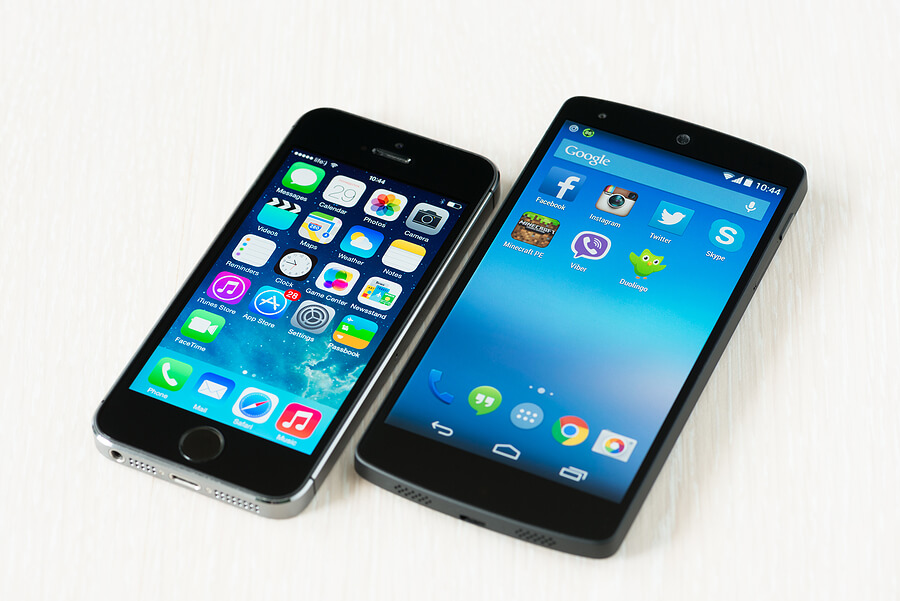Android vs. iPhone Users: Main Differences in 2024
Android dominates in lower-income areas, while iPhone users express brand loyalty and higher purchasing power. From hardware preferences to app ecosystems, let's read here.

Android vs. iPhone: Market Share and App Ecosystem
A worldwide phenomenon, the battle of Android vs. iPhone has reached 97% of the overall mobile operating system market share between the platforms. Android, with 70.46% of the market, is a clear leader due to its broad price range and lower entry-level cost. This considerably helps in penetrating lower-income areas and undeveloped nations. In contrast, the Apple iOS platform, with a 28.83% share, is still seeing its profitability grow as its iOS users are more engaged and active than the Android ones. (according to Statista Q3, 2023)
Both Android and iPhone, offer a wide collection of apps in their marketplace. However, they may differ among themselves mainly in terms of availability, product quality, and pricing models. The Google Play Store on Android has a much higher number of apps compared to other stores, which contain 3.55 million apps. This diverse app selection and customization is definitely the strongest appealing point about it. To the contrary, the Apple App Store furnishes about 1.6 million apps, with the strictness of the app review process being focused on the quality and not the number.
Demographics: Who are Android and iPhone Users?
It is important to know the demographics of Android and iPhone users to target the right audience and craft an app development strategy. The most critical aspect here, however, is that the end results may be different since people have different characteristics.
Android Users:
- Demographics:Android users are mostly male, and many of them are browsing the web from less developed countries or areas with low income. They represent a diverse population, being particularly numerous among the persons belonging to the 16–24 and 25–34 age groups.
- Purchasing behavior: Android users are more price-conscious and have less brand loyalty. They are not biased toward one brand or operating system at all; they may change between phones depending on the cost factor and personalization options.
- Customization and fragmentation: Android's open source feature allows for enhanced personalization that attracts those who value creativity and also the possibility of changing the look and behavior of their devices.
- App preferences: Android users tend to go for apps that help them with the utility quickly, for example, launchers and speed boosters. On the other hand, they are a perfect audience to market ad-supported apps, and they are willing to spend on apps with utility functions.
- Market share: The top dominance of Android OS depends on the fact that such an operating system is preferred in lower income areas and in countries that are developing. This makes it the choice of the people who are seeking affordability, diversity, and choice.
iPhone Users:
- Demographics: iPhone users are often the ones who have a higher income and higher education and are more likely to stay in urban areas. They are popular among young to middle aged people and have a stronger presence within the 16–34 age group.
- Brand loyalty: For iPhone users, it may be seen as strong brand loyalty as they are willing to buy a new model upon its launch. They are prepared to pay more for Apple’s products, which are derived not only from quality, innovation, and trust, which are intrinsic to the brand.
- User experience and satisfaction: iPhone users truly appreciate the stunning, effortless, and smooth functionality of the iOS user interface. They see the benefits of smooth integration between devices and software and are also end users in this revolution that focuses on security, privacy, and performance.
- Device ecosystem: iPhone users usually immerse themselves all the way into the Apple ecosystem by using several Apple products, such as Macs, iPads, Apple Watches, and AirPods. They enjoy to-sync data and services from any device of any brand.
- Market share: However, iOS has a smaller market share globally. But in the United States, iOS holds the biggest share of the market. The reason for this is the fact that Apple has a good reputation for innovation, quality, and prestige all over the world.
Key differences between Android and iPhone Users
In the context of mobile technology, the rivalry between Android and iPhone users is defined not only by their distinct preferences but also by their user experiences. Let's look at the crucial purposes that are unique to the two user groups.
| Key Differences | Android Users | iPhone Users |
| Customization | Users love personalizing their devices with flexible interfaces, widgets, and themes | Users appreciate a sleek and standardized experience, following Apple's design philosophy |
| Affordability | Android users enjoy a broad range of budget-friendly devices | iPhone users typically invest in premium-priced devices, and prioritize brand loyalty |
| App Ecosystem | Benefit from the open Google Play Store with a vast array of apps | Experience a curated App Store known for strict quality control |
| Update Experience | Experience varied update schedules based on device manufacturers and carriers | Enjoy prompt and synchronized updates across the iOS ecosystem |
| Device Integration | Often use devices from different manufacturers that leads to less space for integration | Benefit from seamless integration within Apple's ecosystem |
| Hardware Diversity | Have the luxury of choosing from a wide range of devices with diverse specifications | Experience consistency in design and build across different models |
| Privacy Settings | Privacy permissions influenced by manufacturers and apps | Cares Apple's commitment on privacy |
How do Android and iPhone Users Differ?
In addition to their demographics, Android and iOS users have their own unique patterns of behavior, preferences, and usage. These distinctions in turn lead to the ways in which apps are developed, their monetization strategies, and the interaction of the users with them.
1. App Engagement and Retention:
- User engagement: iPhone users are more likely to spend more time with their apps than average Android owners, which results in them spending nine more hours per month compared to Android users. Of course, iPhone owners are also known to be "power users", who also search for different kinds of information and apps.
- In-app engagement: When compared to Android, when the different app involvement metrics of iOS are evaluated, the latter excels in the number of registrations, purchases, reservations, and in-app purchases. IOS, therefore, is more sophisticated in terms of designs, while Android is more diverse but has a greater frequency of media usage.
- Retention: Loyalty to iPhone brands is one of the attributes that sets Apple apart among smartphone users, with the majority of customers remaining in the family of Apple products. Android users represent those low-brand-loyal ones on the retention rate side, while iOS users are more.
2. Purchasing behavior and monetization:
- In-app purchases: iPhone users have a greater tendency to make in-app purchases, than Android users. Those who prefer to subscribe to premium services and participate in regular in-app shopping are on the high side.
- Paid Apps vs. Ad-Supported Apps: Android users are less willing to make the payment for apps and will rather go for the ad-supporting version of the apps. They are the ones who are ready to shell out money on similar utility apps, such as the ones for launchers and performance boosters, but iOS users have higher acceptance of app purchases.
- Consumer spend: With a higher median income, iPhone users, on the other hand, are more wealthy than Android users, which results in a higher purchasing power. They generate a lot of revenue with applications and in-app purchases, so the platform gets more profitable.
- Mobile Ads: Mobile ads are the main source of revenue for Android apps, as Android users demonstrate a higher percentage of the mobile phone user base and a greater tendency to watch the ads.
3. Push notifications and engagement:
- Push notification behavior: Android and iOS audience members' behavior towards push notifications differs from each other. The higher open rate for push notifications by Android Operating System users could be because the notifications may show up on the lock screen, which will always be visible and will be opened while the user gets ready. As opposed to Android, iOS users’ interaction time to push notifications is quicker, demonstrating a higher quality of interaction.
- Engagement time: iOS users whose attention is gained by push notifications respond within 7 minutes on average, while it takes 48 minutes on average for Android users to respond after being engaged by the same. This gap plays a key role in emphasizing accurate comprehension of platforms’ differences and drawing up personalized push notification strategies.
Choose the Right Platform for your Mobile App
When choosing which platform to target for your mobile app, some critical factors should be looked at, like which market you are going to hit, how the audiences will fit in demographically, and how you will handle the development process with the revenue generation mechanisms.
Target market and demographics
Analyze your target market's tastes, income, and location to determine whether the dominant platform is the best one. In markets with low income and a taste for customization, Android could probably have the upper hand, while iOS could be the choice in the case of trends set on premium products.
App development considerations
Think about the programming languages, the development tools, and the resources that each platform needs when you determine them. Developing apps with Android may demand Java, C/C++, or Kotlin, while iOS development utilizes Objective-C or Swift. The factors of accessibility to the developers and project duration should also be included.
Revenue generation strategies
Evaluate your app's monetization model and decide which platform will aid your goals. On the other hand, iOS classics are the real moneymakers because they charge more for in-app purchases and consumer spending; hence, they can sustain premium models, subscriptions, and in-app purchases. Advertisement supported apps and utility app monetization are the areas where the Android platform leads.
After all, what platform you decide to develop your next project on depends on your intended consumers, the needs of the project, and, of course, your profit expectations. Broadly speaking, it is advisable to perform in-depth research, comprehend user behavior, and skillfully develop and implement an app marketing strategy.
Conclusion
At the end, we must say, it is essential for every company whose objective is to launch a successful mobile app to understand these differences and thus be ready to effectively reach its potential market. Taking into account demographics, app engagement patterns, purchase habits, and monetization schemes, you may make a wise judgment on whether to target iPhone or Android users.
After reading this helpful post, if you feel confident, go ahead and evaluate whether to invest in Android or iOS apps. As for the next step in the way of mobile success, we’re happy to see you there. Give us an opportunity to discuss your project right now and gain complete confidence that our iOS and Android mobile development services will be the major factors contributing to your business growth.
